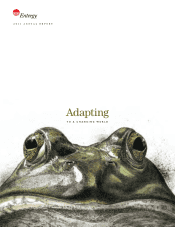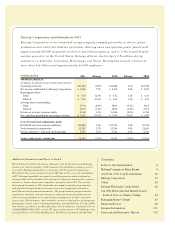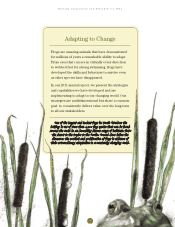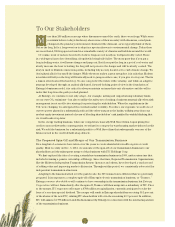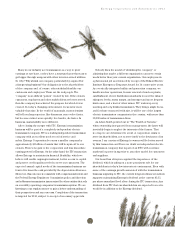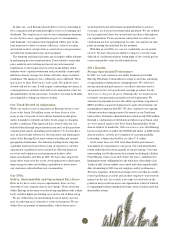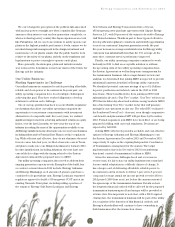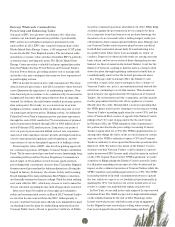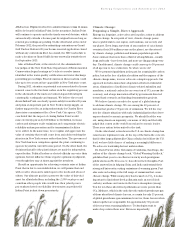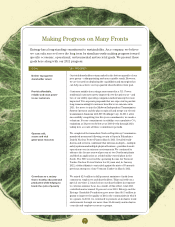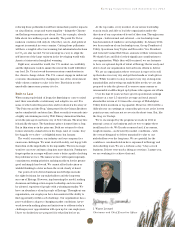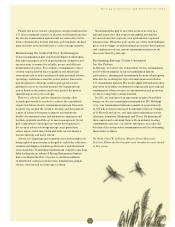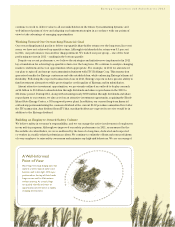Entergy 2011 Annual Report Download - page 8
Download and view the complete annual report
Please find page 8 of the 2011 Entergy annual report below. You can navigate through the pages in the report by either clicking on the pages listed below, or by using the keyword search tool below to find specific information within the annual report.
Entergy Wholesale Commodities:
Preserving and Enhancing Value
Our goal at EWC is to preserve and enhance the value that
exists in our wholesale generation portfolio. Operationally,
EWC set the second highest annual net generation for its
nuclear fleet in 2011. EWC also completed its purchase of the
Rhode Island State Energy Center, a 583-megawatt CCGT plant
located in the ISO New England market. The investment adds
standalone economic value and also diversifies EWC’s portfolio
across fuel type and dispatch merit. The Rhode Island State
Energy Center provides a valuable backstop against firm sales
from the Pilgrim Nuclear Power Station and Vermont Yankee
Nuclear Power Station, providing another tool to manage risk
and reduce the unit-contingent discounts we have experienced
in past hedging actions.
EWC is keenly focused on price risk management. The steep
drop in forward prices since mid-2011 across the entire forward
curve illustrates the importance of maintaining vigilance. Near-
term forward prices continue to be constrained by excess reserve
margins and domestic shale gas production that is outpacing
demand. In addition, the mild winter resulted in storage greater
than anticipated. Previously, we accelerated our near-term
hedging activities consistent with our short-term point of view
on natural gas and power prices. Hedging activity, excluding the
Palisades Power Plant’s long-term power purchase agreement,
through the end of 2011 resulted in 77 terawatt-hours of planned
nuclear generation hedged through 2016 at $800 million above
end-of-February-2012 market prices. Long term, our point of
view on power prices remains bullish on heat rate expansion
associated with ongoing economic growth and implementation
of new environmental regulation and/or legislation, and the
expectation of a more disciplined approach to drilling activity.
Preserving the value of EWC also involves gaining approvals
for continued operation of Pilgrim, Vermont Yankee and Indian
Point. The license renewal process has become frustratingly long,
extending well beyond the Nuclear Regulatory Commission’s
stated target of 30 months to review license applications in
proceedings with contentions. At more than 72 months, Pilgrim’s
license renewal process has the dubious distinction of being the
longest in history. In January, the Atomic Safety and Licensing
Board dismissed the last pending late-filed Pilgrim contention
and formally terminated its proceedings. Final decision making
now rests with the NRC, which may choose to wait to issue the
20-year extended operating license until all appeals are resolved.
After more than 60 months of a thorough and exhaustive
safety and environmental review, in March 2011 Vermont Yankee
received its license renewal from the NRC. Subsequently, it
became clear that Vermont state officials were singularly focused
on shutting down the plant by withholding authority from the
Vermont Public Service Board to grant the Certificate of Public
Good for continued operation after March 21, 2012. While filing
a lawsuit against the government is never a simple decision
for a corporate board and was not our preferred strategy, the
decision to do so was made after a multi-pronged, multi-year
effort failed to find common ground with the state. Entergy and
our Vermont Yankee nuclear power plant became a political
football that was kicked almost daily. It was frustrating to be
in a public battle where there were seemingly no “rules” of
conduct. Respect for others and the truth are among our most
basic values, and we never violated these during the process.
Instead, we filed a lawsuit in the federal District Court for the
District of Vermont, seeking to halt the state’s actions to shut
down the plant through legislating authority for itself that is
constitutionally reserved for the federal government alone.
In a 102-page order in January 2012, the District Court
ruled that certain of the state’s attempts to force closure of
Vermont Yankee are, in fact, unconstitutional and forbade the
state from continuing to act in this manner. This decision is
good news for our approximately 600 employees at Vermont
Yankee, the environment and the community, and also stands
for the proposition that the rule of law applies to everyone.
Shortly after the order, Entergy filed a motion requesting that
the VPSB grant, based on the existing record in its proceeding,
Vermont Yankee’s pending application for a new CPG, and the
state of Vermont filed a notice of appeal of the District Court’s
ruling to the U.S. Court of Appeals for the Second Circuit.
In February 2012, the VPSB submitted a list of questions to
the parties involved in the proceeding concerning Vermont
Yankee’s application for a CPG. The VPSB’s questions relate to,
among other things, the effect of the recent decision on certain
aspects of the VPSB’s authority to issue a CPG and Vermont
Yankee’s authority to store spent fuel from its operations after
March 21, 2012. We believe the intent of the District Court’s
decision was that Vermont Yankee could continue to operate
under its renewed NRC license until a final decision is reached
on the CPG request. Based on the VPSB’s questions, we made
a number of filings asking the District Court to provide clarity
for all parties regarding certain aspects of the decision and its
impact on the continued operation of Vermont Yankee while the
VPSB considers our pending application for a CPG. The VPSB
is an independent body with commissioners sworn to uphold
the law, which we expect to act lawfully and professionally in
granting the CPG. Our most recent action is indicative of our
resolve to assure our stakeholders’ rights are protected.
In New York, we are still in the early stages of license renewal
for Indian Point. The ASLB is expected to begin initial hearings
on the admitted issues by the end of 2012. This stage of the
license renewal process could take many years as suggested
by the Pilgrim license renewal proceeding, where nearly
four years elapsed between the initial hearing and final
6

